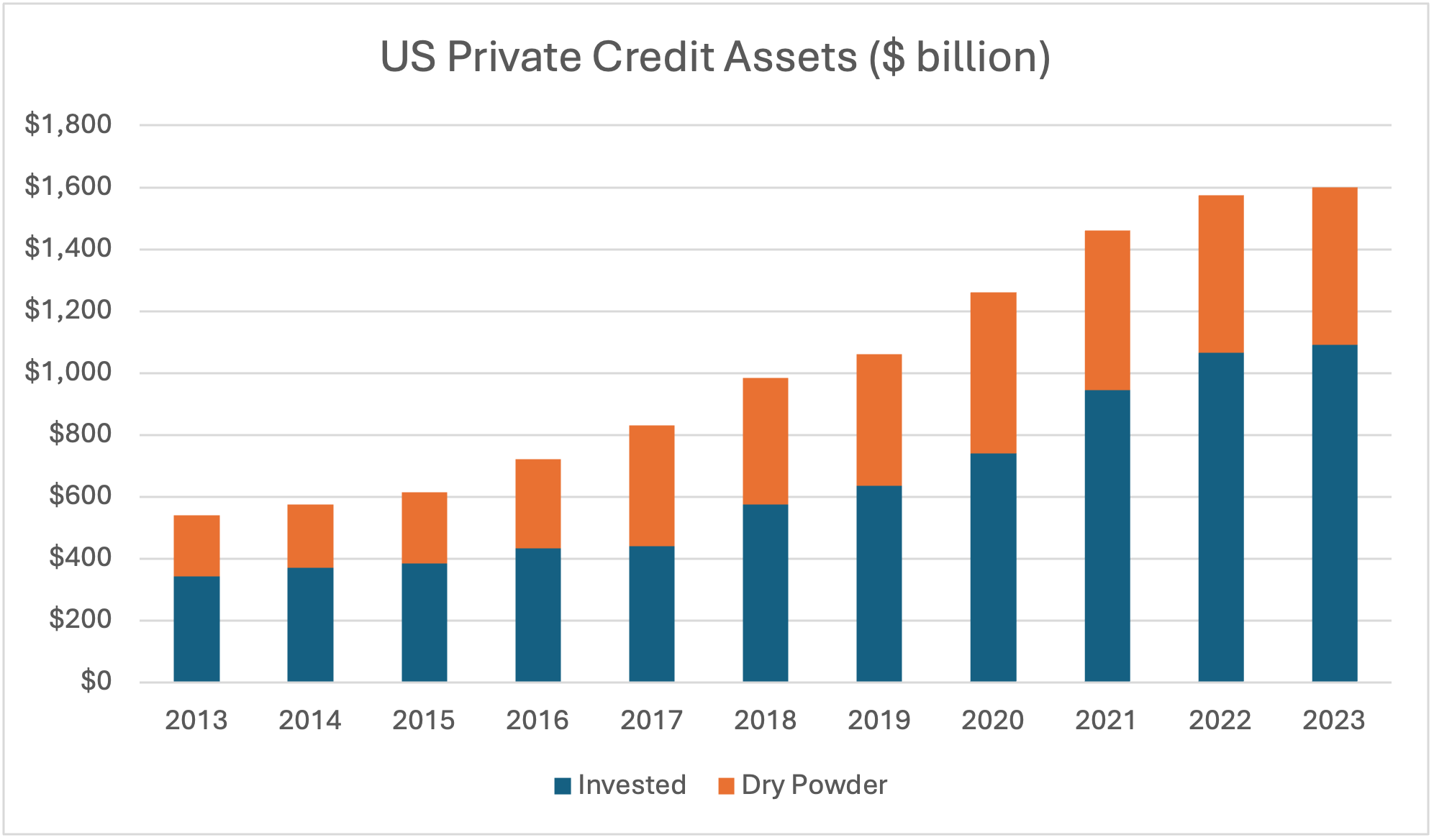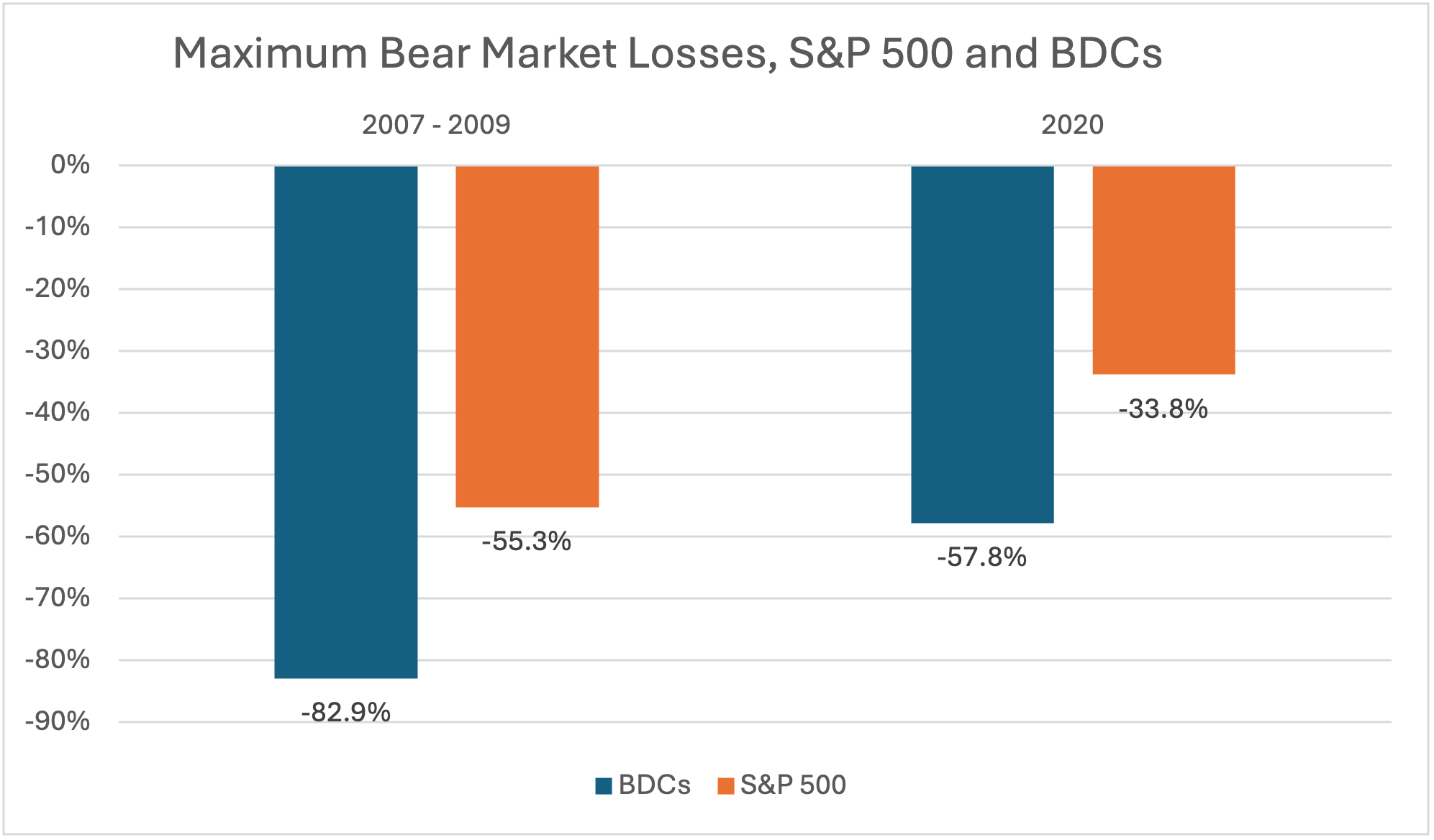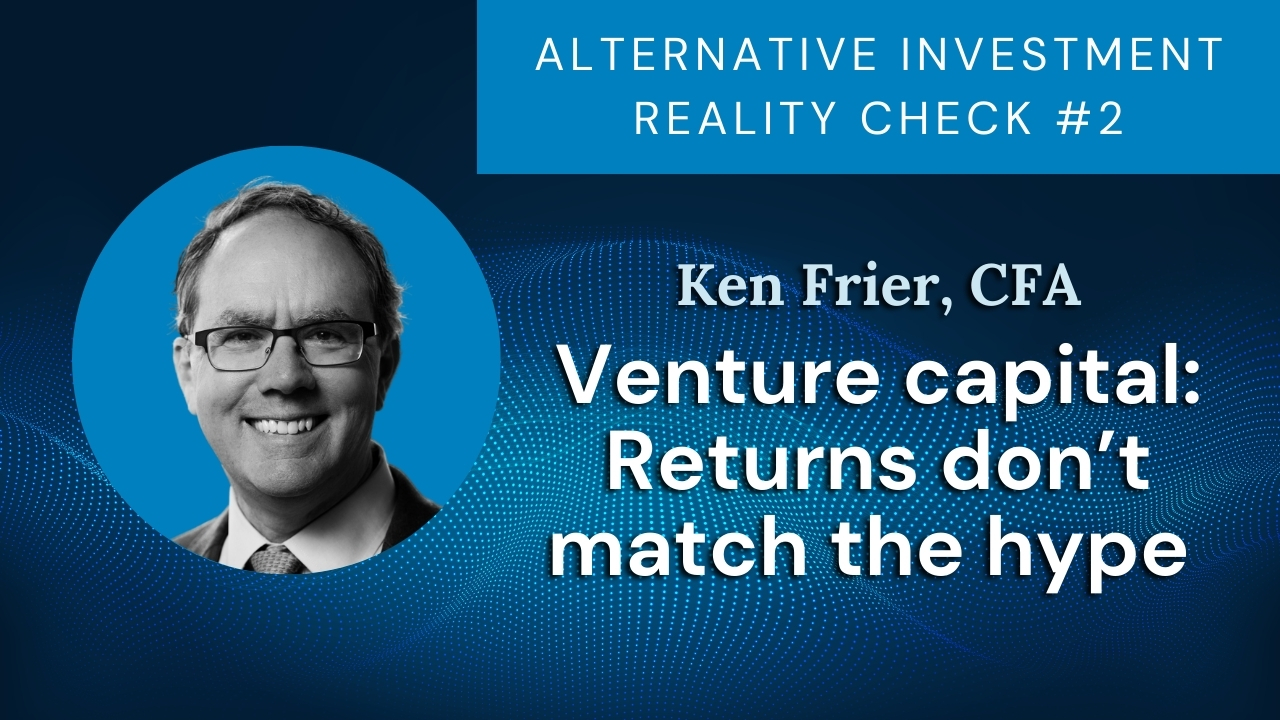Alternative Investments Reality Check Part 5
What’s Discussed
This paper on private credit investment is the fifth of a series on alternative investments.[1] The alternatives industry is making a concerted effort to gather more assets from individuals due to declining appetite from institutional investors. The purpose of the series is to help individual investors recognize the drawbacks of alternative investments before plunging in. If you are considering private credit for your portfolio, you should be aware of the following issues:
- According to a National Bureau of Economic Research study,[2] private debt funds have provided no risk-adjusted return advantage to investors.
- Private credit has a much higher downside risk than most believe.
- Because assets in private credit have surged in benign conditions, the category has not faced a serious test at its current size and scope.
- Success in private credit investment requires specialized organizational capabilities and access.
What is Private Credit?
Private credit firms provide loans and other types of credit, primarily to privately held companies. These firms are typically private partnerships who deploy capital received from institutional investors such as pension funds, non-profits and insurance companies.
Why Private Credit?
The apparent advantages of investing in private credit include:
- A greater opportunity set. There are more than 200,000 middle-market businesses in the US.
- Higher returns. Past returns of private credit exceed the returns of other fixed income categories.
- Perception of “illiquidity premium.” It is generally believed that illiquid investments inherently offer an “illiquidy premium,” leading to higher returns than for equivalent liquid investments.
- Perception of low volatility and correlation. The reported returns of private credit appear to have low volatility and low correlation to other investment types.
Returns as Reported Can Be Misleading…
Private credit performance can be challenging to decipher. Reported investment results are based on the Internal Rate of Return (IRR), a deeply flawed metric which typically exaggerates true performance. Valuations as reported by the private credit firms can flatter performance as well, particularly when the value of loans is falling. More information about why IRR is a misleading performance metric may be found in “The Tyranny of IRR,” a two-part series by Professor Ludovic Phalippou of Oxford University recently posted on the CFA Institute website.[3]
But The Reported Returns Look Great
The reported 10.0% annual return of private credit for the past twenty years is nearly the 10.5% annual return of the S&P 500 US stock index. It is also much higher than could have been obtained in the other primary fixed income categories.
The following chart shows the cumulative return over the past twenty years for five categories of fixed income investments:
- Barclays Aggregate – the most common benchmark for investing in intermediate-term US investment grade fixed income
- Leveraged Loans – bank loans to below investment grade or highly leveraged borrowers
- US High Yield – index of liquid public debt of companies whose credit ratings are below investment grade
- Business Development Companies – a type of private credit fund available to individual investors which lends to small- and mid-sized companies. The majority of BDCs by value are liquid and traded on a stock exchange
- Private Credit – IRRs for illiquid private credit funds organized as private partnerships[4]

Private Credit Assets Growing Quickly
Naturally, investors look at the strong historical performance of private credit and want more of it. There was only $200 billion in US private credit in 2007, the year before the Global Financial Crisis. Assets are now $1.6 trillion,[5] recently surpassing the US public high yield market and the US leveraged loan market.

Private Credit May Provide No Net Skill-Based Return
It’s quite challenging for a private credit investor to determine if they are receiving a favorable return for the risks being taken. A careful study by the National Bureau of Economic Research[6] suggests that, on average, they are not. The study compared the net returns received by limited partners to the returns available in a set of liquid positions that have the same risk profile. The paper’s conclusion is: “Our estimates suggest that the risk-adjusted abnormal return on $1 of capital invested in private credit funds is indistinguishable from zero.”
According to the paper, the gross returns obtained by the private credit firms were 4.0% per year higher than the return available from the liquid asset proxy. But the fees paid to the general partners captured all of the 4% per year of excess return, leaving the limited partners with an excess return of zero. On average, all the financial benefit derived from the skill of the private credit firms went to the members of the firms, and none went to the clients providing the capital.
Private Credit is Riskier Than it Looks
As reported to Pitchbook, the annual volatility of the returns of private credit is just 8%, or about half the volatility of the S&P 500. This appearance of low volatility is misleading. It comes about because private credit firms mute the impact of changes in the market values of their private holdings.
The performance of publicly traded Business Development Companies during the last two bear markets provides a more valid indication of the risk of private credit. As the following chart shows, BDCs had much larger losses than the S&P 500 in the bear markets of 2007 – 2009 and 2020.[7] In fact, over the past twenty years, the BDC index has been nearly twice as risky as the S&P 500. To provide the same ratio of excess return to risk as the S&P 500, BDCs would have needed to return 17.5%/year, rather than the actual return of 7.5%/year. Since BDCs and private credit firms hold similar assets, investors in private credit should recognize that they likely are facing a higher risk of loss than if they owned the US stock market.

Concerns From the IMF
In its Global Financial Stability Report of April 2024, the International Monetary Fund devotes a chapter to private credit and the threats it may pose to financial stability.[8] While the IMF does not currently view private credit as an imminent danger, it enumerates a long list of risk factors, including the ones summarized here:
- Private markets are comparatively lightly regulated and more opaque than bank lending or public debt markets.
- Private credit loans are not liquid, not rated, and subjectively valued. Therefore, it will be difficult for investors or regulators to detect rising risks.
- Private credit has never experienced a severe downturn at its current size and scope.
- Features intended to provide risk mitigation are untested.
- A downturn could reveal the lack of price discovery and supervisory oversight in the asset class and reduce confidence in it.
- Rapid growth, increased competition with banks, and pressure to deploy capital may have led to a deterioration of loan underwriting standards and weakened debt covenants.
- The private credit value chain is complex with many leveraged players. A need for risk reduction in any part of the system could cause the entire network to simultaneously reduce exposures, triggering spillovers to other markets and the broad economy.
- Retail investors in private credit may not adequately understand the investment risks they are taking.
The IMF is also concerned about the effect of higher interest rates on the solvency of companies funded by private credit. The majority of private credit lending is floating-rate and therefore the significant increases in interest rates in 2022 and 2023 impacted borrowers without delay. According to the IMF’s October 2024 Financial Stability Report,[9] using data from BDCs, interest coverage ratios (earnings before interest and taxes divided by interest expense) have fallen by nearly half since December 2021, from 3.0 to 1.6. While actual defaults remain low, the proportion of interest income represented by payment-in-kind (where the interest due is added to the amount owed rather than paid in cash) has doubled in the past five years to approximately 9%.
Who Should Invest in Private Credit?
There is significant dispersion in outcomes from private credit investing. Investors with the best chance to benefit from private credit funds are institutions that have experienced specialists with a deep understanding of the category who are able to identify the best funds and who are perceived as being a desirable limited partner.
Large, sophisticated institutional investors such as the large university endowment funds, have had the means to participate successfully as private credit investors. Such an investor will have direct access to the manager, visit the manager’s premises frequently, and spend many months undertaking an in-depth analysis of the people, investment strategy, prior performance, and business operations of a private credit manager before making a choice to invest. If your private credit manager selection process is done with this exceptional level of understanding, resources, access, and diligence, you might have reason to participate. Otherwise, there is a good chance of ending up with an average private credit fund portfolio or worse, with the drawbacks discussed here.
Summary
Private credit has provided attractive returns in recent years, with the appearance of modest risk. As long as global economic growth is solid and financial conditions are supportive, private credit could continue to deliver for its investors. However, if conditions turn for the worse, investors in private credit could lose a higher proportion of their investment than investors in the stock market, as they have in prior downturns. Moreover, the NBER research indicates that the historical net returns of private credit have been no better than the return available from taking the equivalent basket of risks in liquid markets. Investors who can be patient about deploying capital to private markets could benefit from holding off on additional commitments until the next downturn. When it comes, that downturn will provide better prices for entry as well as enormously useful information about the robustness of the category and the quality of each of the participants.
[1] See our recent commentaries about alternative investments and additional research on alternatives at https://ocio.atlasca.com.
[2] Erel, Isil, Flanagan, Thomas and Weisbach, Michael. March 2024. “Risk-Adjusting the Returns to Private Debt Funds.” National Bureau of Economic Research Working Paper. https://www.nber.org/papers/w32278.
[4] Bloomberg is source for chart data, other than the private credit returns as reported by Pitchbook.
[5] Source: Pitchbook.
[6] See source in footnote 2.
[7] Source: Bloomberg. SPXT for S&P 500 and S&P BDC Total Return Index (SPBDCUT) for BDCs.
[8] International Monetary Fund. April 2024. “Global Financial Stability Report.” https://www.imf.org/en/Publications/GFSR/Issues/2024/04/16/global-financial-stability-report-april-2024.
[9] Source: https://www.imf.org/en/Publications/GFSR/Issues/2024/10/22/global-financial-stability-report-october-2024.
Disclaimer
The information and opinions contained in this presentation are for background purposes only and do not purport to be full or complete. No reliance may be placed for any purpose on the information or opinions contained herein. Atlas does not give any representation, warranty or undertaking, or accept any liability, as to the accuracy or the completeness of the information or opinions contained herein. This presentation does not constitute an offer or solicitation to any person in any jurisdiction. Any such offering will only be made in accordance with the terms and conditions set forth in a private placement memorandum or other offering document. Recipients should not rely on this material in making any future investment decision. We do not represent that the information contained herein is accurate or complete, and it should not be relied upon as such. Opinions expressed herein are subject to change without notice. Certain information contained herein (including any forward-looking statements and economic and market information) has been obtained from published sources and/or prepared by third parties and in certain cases has not been updated through the date hereof. While such sources are believed to be reliable, Atlas and its affiliates do not assume any responsibility for the accuracy or completeness of such information. Atlas does not undertake any obligation to update the information contained herein as of any future date. Any views or opinions expressed may not reflect those of the firm as a whole. Any illustrative models or investments presented in this document are based on a number of assumptions and are presented only for the limited purpose of providing a sample illustration. Any hypothetical performance information contained herein does not represent the results of actual trading using client assets but were achieved by means of the retroactive application of a model. Any sample illustration is inherently subject to significant business, economic and competitive uncertainties and contingencies, many of which are beyond Atlas’s control. One of the limitations of hypothetical performance results is that they are prepared with the benefit of hindsight. In addition, hypothetical trading does not involve financial risk, and no hypothetical trading record can completely account for the impact of financial risk in actual trading. For example, the ability to withstand losses or adhere to a particular trading program in spite of trading losses are material points which can also adversely affect actual trading results. There are numerous other factors related to the markets in general or to the implementation of any specific trading program which cannot be fully accounted for in the preparation of hypothetical performance results and all of which can adversely affect actual trading results. This document may include projections or other forward-looking statements regarding future events, targets, intentions or expectations. Due to various risks and uncertainties, actual events or results may differ materially from those reflected or contemplated in such forward-looking statements. Past performance is no guarantee of future results. Investments are subject to risk, including the possible loss of principal. There is no guarantee that projected returns or risk assumptions will be realized or that an investment strategy will be successful. No representation, warranty or undertaking is made as to the reasonableness of the assumptions made herein or that all assumptions made herein have been stated. Different types of investments involve varying degrees of risk, and there can be no assurance that the future performance of any specific investment, investment strategy, or product made reference to directly or indirectly in this document, will be profitable, equal any corresponding indicated performance level(s), or be suitable for your portfolio. The information contained in this document is based on matters as they exist as of the date of preparation of such material and not as of the date of distribution or any future date and Atlas does not undertake any obligation to update the information contained herein as of any future date. This document does not constitute advice or a recommendation or offer to sell or a solicitation to deal in any security or financial product. It is provided for background purposes only and on the understanding that the recipient has sufficient knowledge and experience to be able to understand and make its own evaluation of the information described herein, any risks associated therewith and any related legal, tax, accounting or other material considerations. To the extent that a reader has any questions regarding the applicability of any specific issue discussed above to his/her/its specific portfolio or situation, it is encouraged to consult with the professional advisor of his/her/its choosing. Investment advisory and management services are provided by Atlas Capital Advisors, Inc. Atlas is registered as an investment advisor with the Securities and Exchange Commission.








